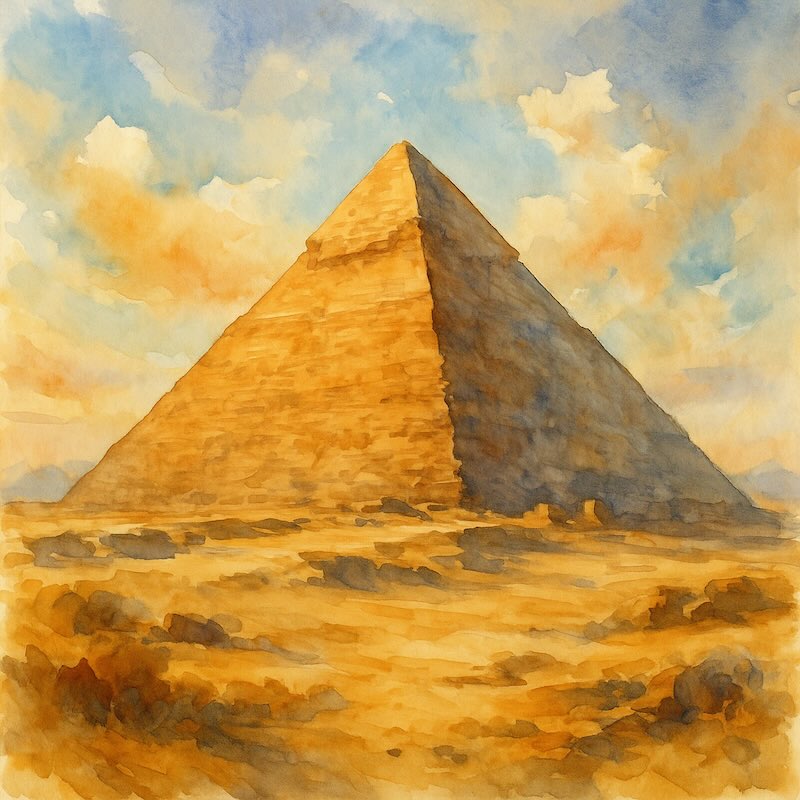Level 1 Reader
390 Words
A Big Pyramid
The Great Pyramid is in Egypt. It is near a big city. The city is called Cairo. The pyramid is very, very big. It is made of stone. The stones are heavy. Many people come to see the pyramid. They take photos. They say, “Wow!” It is old and beautiful.
Long Ago
The pyramid is very old. It is over 4,000 years old. It was made a long time ago. Many workers helped build it. There were no trucks. There were no big machines. But the workers were strong. They used ropes and tools. It was hard work.
A King’s Tomb
The pyramid is a tomb. A tomb is a place for a dead person. The pyramid is for a king. The king’s name was Khufu. He was also called Pharaoh Khufu. The king died. He was put inside the pyramid. He was buried with gold and other things.
How Big Is It?
The pyramid is very tall. It is about 140 meters tall. It was the tallest building in the world for many years. The pyramid has many blocks. The blocks are big. There are more than 2 million blocks! It is very wide, too. Each side is over 230 meters long. That is very long!
Why Visit?
Many people want to see the pyramid. They come by car or bus. They walk around it. They look up at the big stones. Some people go inside. It is dark inside. It is also a little scary. But it is fun and interesting.
A Wonder
The Great Pyramid is special. It is one of the Seven Wonders of the World. It is the only one that is still here today. It is a treasure. It is part of the world’s history.
The Desert
The pyramid is in the desert. There is a lot of sand. It is hot during the day. It is cold at night. Camels walk near the pyramid. Some people ride the camels. They take photos and smile. It is a fun day.
Still a Mystery
We still ask many questions. How did they move the big stones? How did they build the pyramid? We do not know everything. Some people think it was magic. But it was not magic. It was hard work and smart people. The pyramid is still a mystery.
Level 2 Reader
494 Words
A Giant in the Desert
In the hot desert of Egypt stands a giant. This giant is not a person or an animal. It is a pyramid—The Great Pyramid of Giza. It is the largest of the three pyramids near Cairo, Egypt. People from around the world visit it every year. They come to see the last of the Seven Wonders of the Ancient World that still exists today.
The Great Pyramid is more than 4,500 years old. It was built during the time of the Pharaoh Khufu, around 2560 BCE. At that time, Egypt was a powerful and rich kingdom. The pyramid was made to be Khufu’s tomb, where his body would rest after death.
Building the Pyramid
Building the Great Pyramid was not easy. It took thousands of workers and about 20 years to finish. The pyramid is made of over 2 million large stone blocks. Each block weighs about 2.5 tons.
How did people move these heavy stones without modern machines? That is still a mystery. Some experts believe workers used wooden sleds and wet sand to help move the blocks. Others think they built ramps around the pyramid to pull the stones up.
Even with today’s technology, building such a perfect structure would be difficult. The sides of the pyramid are almost perfectly straight, and they face exactly north, south, east, and west.
A Tomb for a King
The pyramid was not just a big triangle in the desert. Inside, there are narrow passageways and rooms. The most important room is the King’s Chamber, where Khufu’s body was placed. There is also a Queen’s Chamber and a Grand Gallery.
Long ago, the pyramid was covered in shiny white stones called casing stones. These made the pyramid shine in the sun. Today, most of those stones are gone because people used them to build other buildings over time.
Although many people believe the pyramid was full of treasure, no gold or jewels have been found inside. Thieves may have taken them long ago. Or perhaps the pyramid never held treasure at all.
A Wonder of the World
The Great Pyramid is the only one of the Seven Wonders of the Ancient World still standing. This shows how well it was built. For over 3,800 years, it was the tallest building in the world, until modern skyscrapers appeared.
Many scientists and historians study the pyramid. They want to understand how it was built and what secrets it may still hold. In recent years, new technology such as 3D scanning and robots has helped researchers explore areas deep inside the pyramid.
A Symbol of Ancient Egypt
Today, the Great Pyramid is one of the most famous landmarks in the world. It is a symbol of ancient Egypt and its great history. Tourists take photos, walk around the base, and try to imagine life thousands of years ago.
The pyramid reminds us of human creativity, hard work, and the desire to leave something behind that lasts forever. When we look at the Great Pyramid, we don’t just see a pile of stones. We see a connection to the past—a message from a king who lived a long time ago.
Level 3 Reader
514 Words
A Wonder of the Ancient World
Standing tall on the outskirts of Cairo, Egypt, the Great Pyramid of Giza has amazed visitors for over 4,500 years. It is the last remaining wonder of the original Seven Wonders of the Ancient World. Even today, its sheer size and precise construction continue to impress architects, historians, and tourists alike.
The pyramid was built as a tomb for the Egyptian Pharaoh Khufu (also known as Cheops) during the Fourth Dynasty, around 2580 BCE. It originally stood at 146.6 meters tall, although erosion and the loss of the outer casing stones have reduced it to about 138.5 meters.
A Monument of Mystery
No one knows exactly how the ancient Egyptians managed to build such a huge structure without modern tools or machinery. More than 2 million limestone blocks, each weighing between 2.5 and 15 tons, were used. Some theories suggest that ramps were used to move the stones into place. Others believe levers or internal spiral systems may have been used.
Despite centuries of study, the Great Pyramid still holds secrets. The internal structure contains chambers, corridors, and shafts whose purpose is not fully understood. Recently, scientists used advanced scanning technology to discover a hidden void inside the pyramid, which may lead to new discoveries in the future.
Engineering Genius
The pyramid’s alignment with the cardinal points—north, south, east, and west—is almost perfect. The level of accuracy suggests the builders had advanced knowledge of astronomy and mathematics. The base is nearly a perfect square, with sides just a few centimeters different in length.
Each block was carefully cut and placed with such precision that even today, it is difficult to fit a knife blade between them. The joints are tight, and the structure has survived countless earthquakes and extreme weather over the centuries. Modern engineers still study the pyramid to understand how it was constructed and why it has lasted so long.
Cultural Significance
For the ancient Egyptians, the pyramid was more than a tomb—it was a gateway to the afterlife. Pharaohs were seen as gods, and their burial places were meant to reflect their divine status. The pyramid’s shape, pointing toward the sky, symbolized a stairway to the heavens.
The Great Pyramid was originally covered in smooth, white Tura limestone that reflected the sun’s light and made it shine like a “jewel of the desert.” Although most of the outer casing has been removed over time, some stones remain at the base.
A Legacy That Endures
Today, the Great Pyramid is a UNESCO World Heritage Site and one of the most visited tourist attractions in the world. Millions of people travel to Egypt each year to stand in its shadow, walk around its massive base, and imagine the civilization that built it.
The pyramid inspires awe not only because of its size and age but because it connects us to the distant past. It reminds us of what human beings are capable of—through imagination, dedication, and teamwork. The Great Pyramid of Giza continues to be a symbol of mystery, endurance, and human achievement.
Extensive Listening
Level 1 Audio
Level 2 Audio
Level 3 Audio
Natural Discussion
AWS Polly & Google Notebook LM
La Gran Pirámides

Lectura nivel 1
358 Palabras
Una Gran Pirámide
La Gran Pirámide está en Egipto. Está cerca de una ciudad grande. La ciudad se llama El Cairo. La pirámide es muy, muy grande. Está hecha de piedra. Las piedras son pesadas. Muchas personas vienen a ver la pirámide. Ellos toman fotos. Dicen: “¡Guau!” Es antigua y hermosa.
Hace Mucho Tiempo
La pirámide es muy antigua. Tiene más de 4,000 años. Se construyó hace mucho tiempo. Muchos trabajadores ayudaron a construirla. No había camiones. No había máquinas grandes. Pero los trabajadores eran fuertes. Usaron cuerdas y herramientas. Fue un trabajo duro.
La Tumba de un Rey
La pirámide es una tumba. Una tumba es un lugar para una persona muerta. La pirámide es para un rey. El rey se llamaba Keops. También se llamaba Faraón Keops. El rey murió. Lo pusieron dentro de la pirámide. Fue enterrado con oro y otras cosas.
¿Qué Tan Grande Es?
La pirámide es muy alta. Mide unos 140 metros de alto. Fue el edificio más alto del mundo por muchos años. La pirámide tiene muchos bloques. Los bloques son grandes. ¡Hay más de 2 millones de bloques! También es muy ancha. Cada lado mide más de 230 metros. ¡Eso es muy largo!
¿Por Qué Visitarla?
Muchas personas quieren ver la pirámide. Vienen en coche o autobús. Caminan alrededor de ella. Miran hacia arriba, a las piedras grandes. Algunas personas entran. Adentro está oscuro. También da un poco de miedo. Pero es divertido e interesante.
Una Maravilla
La Gran Pirámide es especial. Es una de las Siete Maravillas del Mundo. Es la única que todavía existe hoy. Es un tesoro. Es parte de la historia del mundo.
El Desierto
La pirámide está en el desierto. Hay mucha arena. Hace calor durante el día. Hace frío en la noche. Los camellos caminan cerca de la pirámide. Algunas personas montan los camellos. Ellos toman fotos y sonríen. Es un día divertido.
Todavía un Misterio
Todavía hacemos muchas preguntas. ¿Cómo movieron las piedras grandes? ¿Cómo construyeron la pirámide? No sabemos todo. Algunas personas piensan que fue magia. Pero no fue magia. Fue trabajo duro y gente inteligente. La pirámide todavía es un misterio.
Lectura nivel 2
555 Palabras
Un gigante en el desierto
En el caluroso desierto de Egipto se alza un gigante. Este gigante no es una persona ni un animal. Es una pirámide: la Gran Pirámide de Guiza. Es la más grande de las tres pirámides cerca de El Cairo, Egipto. Personas de todo el mundo la visitan cada año. Vienen a ver la última de las Siete Maravillas del Mundo Antiguo que aún existe hoy.
La Gran Pirámide tiene más de 4,500 años. Fue construida durante la época del faraón Keops, alrededor del año 2560 a. C. En ese tiempo, Egipto era un reino poderoso y rico. La pirámide fue hecha para ser la tumba de Keops, donde su cuerpo descansaría después de la muerte.
Construyendo la pirámide
Construir la Gran Pirámide no fue fácil. Se necesitaron miles de trabajadores y unos 20 años para terminarla. La pirámide está hecha de más de 2 millones de bloques de piedra grandes. Cada bloque pesa alrededor de 2.5 toneladas.
¿Cómo movieron estas piedras tan pesadas sin máquinas modernas? Todavía es un misterio. Algunos expertos creen que los trabajadores usaron trineos de madera y arena mojada para mover los bloques. Otros piensan que construyeron rampas alrededor de la pirámide para subir las piedras.
Incluso con la tecnología actual, sería difícil construir una estructura tan perfecta. Los lados de la pirámide son casi perfectamente rectos, y miran exactamente al norte, sur, este y oeste.
Una tumba para un rey
La pirámide no era solo un gran triángulo en el desierto. Dentro, hay pasadizos estrechos y habitaciones. La sala más importante es la Cámara del Rey, donde se colocó el cuerpo de Keops. También hay una Cámara de la Reina y una Gran Galería.
Hace mucho tiempo, la pirámide estaba cubierta con piedras blancas brillantes llamadas piedras de revestimiento. Estas hacían que la pirámide brillara bajo el sol. Hoy, la mayoría de esas piedras ya no están, porque la gente las usó para construir otros edificios con el paso del tiempo.
Aunque muchas personas creen que la pirámide estaba llena de tesoros, no se ha encontrado oro ni joyas en su interior. Es posible que ladrones las hayan robado hace mucho tiempo. O quizás la pirámide nunca tuvo tesoros.
Una maravilla del mundo
La Gran Pirámide es la única de las Siete Maravillas del Mundo Antiguo que aún se mantiene en pie. Esto muestra lo bien que fue construida. Durante más de 3,800 años, fue el edificio más alto del mundo, hasta que aparecieron los rascacielos modernos.
Muchos científicos e historiadores estudian la pirámide. Quieren entender cómo fue construida y qué secretos puede tener aún. En los últimos años, nuevas tecnologías como escáneres 3D y robots han ayudado a los investigadores a explorar zonas profundas dentro de la pirámide.
Un símbolo del antiguo Egipto
Hoy, la Gran Pirámide es uno de los monumentos más famosos del mundo. Es un símbolo del antiguo Egipto y de su gran historia. Los turistas toman fotos, caminan alrededor de la base e intentan imaginar cómo era la vida hace miles de años.
La pirámide nos recuerda la creatividad humana, el esfuerzo y el deseo de dejar algo que dure para siempre. Cuando miramos la Gran Pirámide, no solo vemos un montón de piedras. Vemos una conexión con el pasado: un mensaje de un rey que vivió hace mucho tiempo.
Lectura nivel 3
546 Palabras
Una Maravilla del Mundo Antiguo
Erguida en las afueras de El Cairo, Egipto, la Gran Pirámide de Guiza ha asombrado a los visitantes durante más de 4.500 años. Es la única maravilla que aún existe de las Siete Maravillas del Mundo Antiguo. Incluso hoy, su tamaño imponente y su construcción precisa siguen impresionando a arquitectos, historiadores y turistas por igual.
La pirámide fue construida como tumba para el faraón egipcio Keops (también conocido como Khufu) durante la Cuarta Dinastía, alrededor del año 2580 a. C. Originalmente medía 146,6 metros de altura, aunque la erosión y la pérdida de las piedras de revestimiento exterior la han reducido a unos 138,5 metros.
Un Monumento Misterioso
Nadie sabe con certeza cómo los antiguos egipcios lograron construir una estructura tan enorme sin herramientas ni maquinaria moderna. Se utilizaron más de 2 millones de bloques de piedra caliza, cada uno con un peso de entre 2,5 y 15 toneladas. Algunas teorías sugieren que se usaron rampas para mover las piedras hasta su lugar. Otras creen que se emplearon palancas o sistemas de espirales internas.
A pesar de siglos de estudio, la Gran Pirámide aún guarda secretos. Su estructura interna contiene cámaras, pasillos y conductos cuya función no se entiende del todo. Recientemente, científicos usaron tecnología de escaneo avanzada para descubrir un vacío oculto dentro de la pirámide, lo que podría conducir a nuevos hallazgos en el futuro.
Genio de la Ingeniería
La alineación de la pirámide con los puntos cardinales —norte, sur, este y oeste— es casi perfecta. Este nivel de precisión sugiere que los constructores poseían conocimientos avanzados de astronomía y matemáticas. Su base es casi un cuadrado perfecto, con lados que difieren solo unos pocos centímetros entre sí.
Cada bloque fue cortado y colocado con tanta precisión que incluso hoy es difícil insertar una hoja de cuchillo entre ellos. Las uniones son estrechas y la estructura ha sobrevivido a innumerables terremotos y condiciones climáticas extremas a lo largo de los siglos. Los ingenieros modernos aún estudian la pirámide para comprender cómo fue construida y por qué ha perdurado tanto tiempo.
Importancia Cultural
Para los antiguos egipcios, la pirámide era más que una tumba: era una puerta al más allá. Los faraones eran considerados dioses, y sus lugares de entierro debían reflejar su estatus divino. La forma de la pirámide, apuntando hacia el cielo, simbolizaba una escalera hacia los cielos.
Originalmente, la Gran Pirámide estaba cubierta de piedra caliza blanca de Tura, que reflejaba la luz del sol y la hacía brillar como una “joya del desierto”. Aunque la mayor parte del revestimiento exterior ha sido retirada con el tiempo, aún se conservan algunas piedras en la base.
Un Legado Duradero
Hoy en día, la Gran Pirámide es un Sitio del Patrimonio Mundial de la UNESCO y una de las atracciones turísticas más visitadas del mundo. Millones de personas viajan a Egipto cada año para contemplarla, caminar alrededor de su enorme base e imaginar la civilización que la construyó.
La pirámide inspira asombro no solo por su tamaño y antigüedad, sino porque nos conecta con el pasado lejano. Nos recuerda de lo que los seres humanos somos capaces: con imaginación, dedicación y trabajo en equipo. La Gran Pirámide de Guiza sigue siendo un símbolo de misterio, resistencia y logro humano.
Escucha extensiva
Nivel 1 audio
Nivel 2 audio
Nivel 3 audio
Discusión natural
AWS Polly & Google Notebook LM

